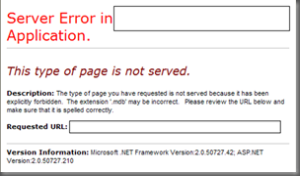For an internal application at my company, very particular users have the rights to download an MDB that contains links to a replicated instance of a DB. This was done so they could create their own queries without any assistance from IT - essentially a poor man's Cognos or Reporting Services. This worked fine in .Net 1.1.
We are currently in the process of upgrading this application to .Net 2.0 and one of the developers on the project brought to my attention that the download was failing with a message stating:

She did some research and uncovered this forum post with step by step instructions on how to re-enable the downloading of an Access database.
Please keep in mind, though, that this was done for security purposes - so any page that links to a secured Access DB - should be secured in a variety of ways:
1. Code Access Security:
1: <PrincipalPermission(SecurityAction.Demand, _
2: Authenticated:=True, _
3: Role:="Secured User")> _
This should be placed in the code-behind on the page with the link to the file. As you can see, the "Role" property will secure this page to just a user in a particular role. If you have a page that is accessible to multiple roles, you can stack the class attributes on top of each other as seen here:
1: <PrincipalPermission(SecurityAction.Demand, _
2: Authenticated:=True,
3: Role:="First Role")> _
4: <PrincipalPermission(SecurityAction.Demand, _
5: Authenticated:=True,
6: Role:="Second Role")> _
7: Partial Class PagesToBeSecured
2. File Access Restriction:
Also, by putting a web.config in the folder that houses the Access DB, you can secure access to the contents of a particular folder. For example with a structure of:
1: Root/Downloads/Database/db.mdb
You can put a web.config in the "Database" folder that restricts access to that folder to a particular user/role/etc. For example, the web.config in this example would look something like:
1: <?xml version="1.0" encoding="utf-8"?>
2: <configuration>
3: <system.web>
4: <authorization>
5: <allow roles="Role 1" />
6: <allow roles="Role 2"/>
7: <deny users="*" />
8: </authorization>
9: </system.web>
10: </configuration>
As you can see, we are only allowing users in roles Role 1 and Role 2 to access the contents of this folder. If any other users attempt to access the file, they will get a Page Cannot Be found exception.
In conclusion - if you are going to remove this particular restriction in IIS to allow users to download Access DB files directly from your web application - then you shouldn't completely discount security and you implement both of the following measures.
Enjoy!